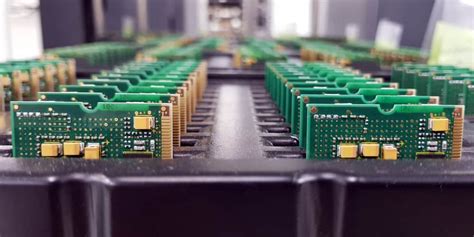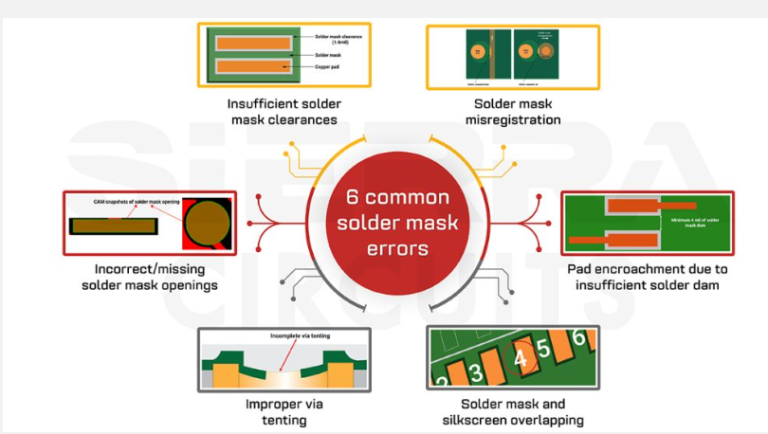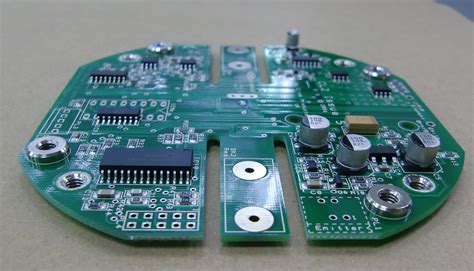Design of PCB board of RF switch module functional circuit
With the development of modern wireless communication systems, mobile communication, radar, satellite communication and other communication systems have higher requirements for the switching speed, power capacity and integration of the transceiver switch. Therefore, it is of great significance to study bus technology and develop bus modules that meet the special requirements of the military. We will use the idea of virtual instrument to implement the hardware circuit in software. The RF switch designed below can be directly controlled by the computer and can be easily integrated with the bus test system to maximize the application of computer and microelectronics technology in today’s test field, which has broad development prospects.

1 Design and implementation of VXI bus interface circuit
VXIbus is an extension of VMEbus in the field of instruments. It is a modular automatic instrument system controlled by computers. It relies on effective standardization and adopts a modular approach to achieve serialization, generalization and interchangeability and interoperability of VXIbus instruments. Its open architecture and PlugPlay method fully meet the requirements of information products. It has the advantages of high-speed data transmission, compact structure, flexible configuration, good electromagnetic compatibility, etc., so the system is very convenient to build and use, and its application is becoming more and more extensive. It has gradually become the preferred bus for high-performance test system integration.
VXI bus is a completely open modular instrument backplane bus specification suitable for various instrument manufacturers.
VXI bus devices are mainly divided into: register-based devices, message-based devices and memory-based devices. At present, register-based devices account for the largest proportion in applications (about 70%). The VXIbus register-based interface circuit mainly includes: bus buffer driver, addressing and decoding circuit, data transmission response state machine, configuration and operation register group. Among the four parts, except for the bus buffer driver, which is implemented by 74ALS245 chip, the rest are implemented by FPGA. A FLEX10K chip EPF10K10QC208-3 and an EPROM chip EPC1441P8 are used, and the corresponding software MAX+PLUSⅡ is used for design and implementation.

1.1 Bus buffer drive
This part completes the buffer reception or drive of the data line, address line and control line in the VXI backplane bus to meet the requirements of the VXI standard signal. For the A16/D16 device, it is only necessary to realize the buffer drive of the backplane data bus D00~D15. According to the requirements of the VXI bus specification, this part is implemented with two 74LS245s, and is selected by DBEN* (generated by the data transmission response state machine).
1.2 Addressing and decoding circuit
The addressing lines include address lines A01~A31, data selection lines DS0* and DS1, and long word lines LWORD. The control lines include address selection lines AS* and read/write signal lines WRITE*.
This circuit is designed using the schematic design method of MAX+PLUSⅡ. The existing components in the component library are used for design, and two 74688s and one 74138 are used.
This functional module decodes the address lines A15~A01 and the address modification lines AM5~AM0. When the device is addressed, it receives the address information on the address lines and address modification lines, and compares it with the logical addresses LA7~LA0 set by the hardware address switch on this module. If the logical value on AM5~AM0 is 29H or 2DH (because it is an A16/D16 device), the address lines A15 and A14 are both 1, and the logical value on A13~A06 is equal to the logical address of the module, the device is addressed (CADDR* is true). Then the result is sent to the next level of decoding control, and the register of the module in the 16-bit address space is selected by decoding the addresses A01~A05.
1.3 Data transmission response state machine
The data transmission bus is a set of high-speed asynchronous parallel data transmission buses, which is the main component of VMEbus system information exchange. The signal lines of the data transmission bus can be divided into three groups: addressing lines, data lines, and control lines.
This part of the design adopts the text input design method of MAX+PLUSⅡ. Since the timing of DTACK* is relatively complex, AHDL language is used for design and implemented through state machine.
This functional module configures the control signals in the VXI backplane bus and provides timing and control signals for the standard data transmission cycle (generating data transmission enable signal DBEN, bus response signal DTACK required to complete data transmission, etc.). When data transmission is performed, the system controller first addresses the module and sets the corresponding address strobe line AS, data strobe lines DS0, DS1* and WRITE* signal line that controls the data transmission direction to valid levels. When the module detects that the address matches and the control lines are valid, it drives DTACK* to a low level to confirm to the bus controller that the data has been placed on the data bus (read cycle) or has been successfully received (write cycle).
1.4 Configuration Registers
Each VXI bus device has a set of “configuration registers”. The system main controller obtains some basic configuration information of the VXI bus device by reading the contents of these registers, such as device type, model, manufacturer, address space (A16, A24, A32) and required storage space.
The basic configuration registers of VXI bus devices are: identification register, device type register, status register, and control register.
The design of this part of the circuit adopts the schematic design method of MAX+PLUSⅡ, using the 74541 chip to create a functional module.
ID, DT, and ST registers are read-only registers, and the control register is a write-only register. In this design, the VXI bus is mainly used to control the on and off of this batch of switches. Therefore, as long as data is written to the channel register, the on and off state of the relay switch can be controlled. The relay status can also be queried by reading data from the channel register. According to the needs of the module design, write appropriate content in the corresponding data bits, so that the RF switch of the functional module can be effectively controlled.
2 Design of module function circuit board
Each VXI bus device has a set of “configuration registers”. The system main controller obtains some basic configuration information of the VXI bus device by reading the contents of these registers, such as device type, model, manufacturer, address space (A16, A24, A32) and required storage space.
The frequency range of the RF circuit is about 10kHz to 300GHz. As the frequency increases, the RF circuit exhibits some characteristics different from low-frequency circuits and DC circuits. Therefore, when designing the RF circuit board, special attention should be paid to the impact of the RF signal on the board. This RF switch circuit is controlled by the VXI bus. In order to reduce interference in the design, the bus interface circuit part and the RF switch function circuit are connected by a flat cable. The following mainly introduces the design of the PCB board of the RF switch function circuit part.
2.1 Layout of components
Electromagnetic compatibility (EMC) refers to the ability of an electronic system to work normally according to the design requirements in a specified electromagnetic environment. For the RF circuit PCB design, electromagnetic compatibility requires that each circuit module should not generate electromagnetic radiation as much as possible and have a certain ability to resist electromagnetic interference.
The layout of components directly affects the interference and anti-interference ability of the circuit itself. It also directly affects the performance of the designed circuit. The general principle of layout: components should be arranged in the same direction as much as possible, and the phenomenon of poor welding can be reduced or even avoided by selecting the direction in which the PCB enters the tin melting system; there must be at least 0.5mm spacing between components to meet the tin melting requirements of the components. If the space of the PCB board allows, the spacing of the components should be as wide as possible.
The reasonable layout of components is also a prerequisite for reasonable wiring, so it should be considered comprehensively. In this design, the relay is used to convert the channel of the RF signal, so the relay should be as close to the signal input and output ends as possible to minimize the routing length of the RF signal line, so as to consider the next step of reasonable wiring. In addition, this RF switch circuit is controlled by the VXI bus, and the impact of the RF signal on the VXI bus control signal is also a problem that must be considered during layout.

2.2 Wiring
After the layout of the components is basically completed, wiring should be started. The basic principle of wiring is: when the assembly density permits, try to use low-density wiring design, and the signal routing should be as consistent as possible, which is conducive to impedance matching.
For RF circuits, unreasonable design of the direction, width, and line spacing of signal lines may cause cross interference between signal transmission lines; in addition, the system power supply itself also has noise interference, so comprehensive consideration must be given to reasonable wiring when designing the RF circuit PCB.
When wiring, all wiring should be away from the border of the PCB board (about 2mm) to avoid wire breakage or hidden dangers of wire breakage during PCB board production. The power line should be as wide as possible to reduce loop resistance. At the same time, the direction of the power line and ground line should be consistent with the direction of data transmission to improve anti-interference ability. The signal lines should be as short as possible and the number of vias should be minimized; the shorter the connection between components, the better, to reduce distributed parameters and mutual electromagnetic interference; incompatible signal lines should be kept as far away from each other as possible, and parallel wiring should be avoided as much as possible, and the signal lines on the front and back sides should be perpendicular to each other: when wiring, a 135-degree angle should be used where a corner is required to avoid turning a right angle.
In the above design, the PCB board uses a four-layer board. In order to reduce the impact of the RF signal on the VXI bus control signal, the two signal lines are placed on the middle two layers respectively, and the RF signal line is shielded with a ground via.

2.3 Power line and ground line
In the wiring of the RF circuit PCB design, it is necessary to emphasize the correct wiring of the power line and the ground line. The reasonable selection of the power and ground lines is an important guarantee for the reliable operation of the instrument.
A considerable number of interference sources on the PCB board of the RF circuit are generated by the power supply and ground line, among which the noise interference caused by the ground line is the largest. According to the size of the PCB board current, the power line and the ground line should be designed as thick and short as possible to reduce the loop resistance.
At the same time, the direction of the power line and the ground line should be consistent with the direction of data transmission, which helps to enhance the anti-noise ability. If conditions permit, try to use a multi-layer board. The noise of the four-layer board is 20dB lower than that of the double-layer board, and the six-layer board is 10dB lower than that of the four-layer board.
In the four-layer PCB board designed in this article, the top and bottom layers are both designed as ground layers. In this way, no matter which layer of the middle layer is the power layer, the physical relationship between the power layer and the ground layer, which are close to each other, forms a large decoupling capacitor, reducing the interference caused by the ground wire.

The ground layer uses a large area of copper. Large area copper has the following functions:
(1) EMC. For large areas of ground or power copper, it will play a shielding role.
(2) PCB process requirements. Generally, in order to ensure the electroplating effect or prevent lamination deformation, copper is laid on PCB layers with less wiring.
(3) Signal integrity requirements, give high-frequency digital signals a complete return path, and reduce the wiring of the DC network.
(4) Heat dissipation, special device installation requires copper, etc.
3 Conclusion
The VXI bus system is a modular instrument bus system that is completely open worldwide and suitable for multiple manufacturers. It is currently the newest instrument bus system in the world. The above mainly introduces the development of RF switch modules based on VXI bus. The design of the bus interface and the design of the PCB board of the functional circuit part of the RF switch module are introduced. The RF switch is controlled by VXI bus, which increases the flexibility of switch operation and is easy to use.







